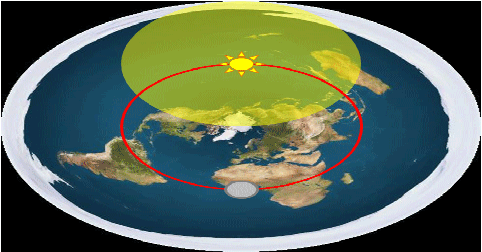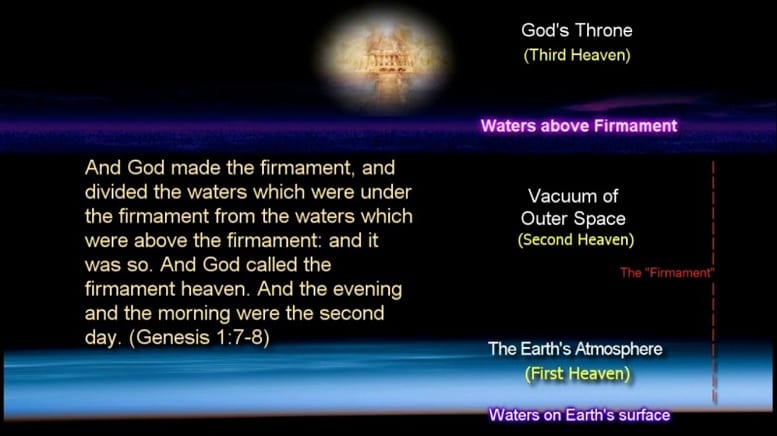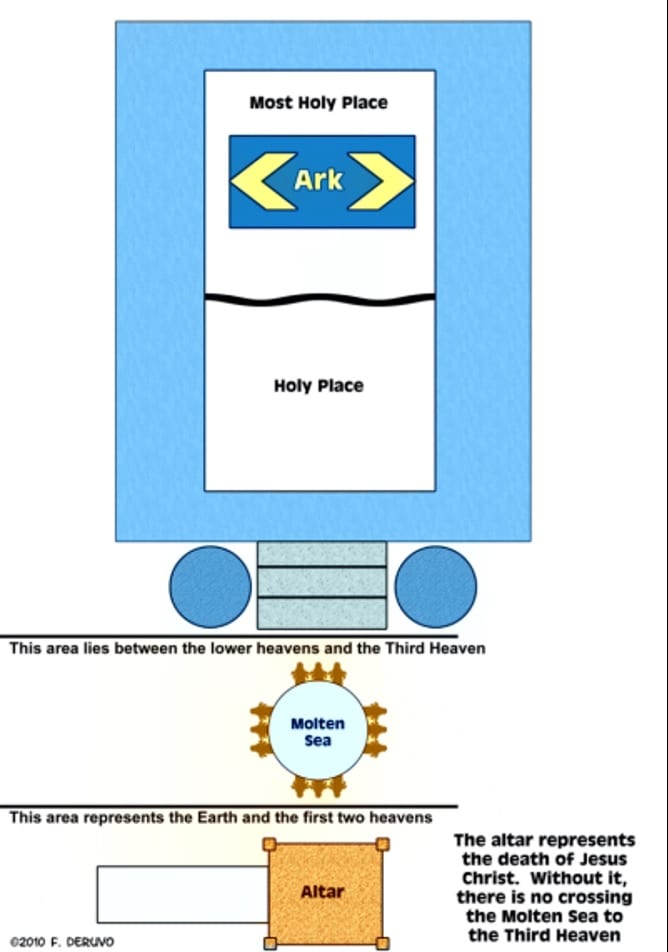The vault of heaven is a crucial concept. The word “firmament” appears in the King James version of the Old Testament 17 times, and in each case it is translated from the Hebrew word raqiya, which meant the visible vault of the sky. The word raqiya comes from riqqua, meaning “beaten out.” In ancient times, brass objects were either cast in the form required or beaten into shape on an anvil. A good craftsman could beat a lump of cast brass into a thin bowl. Thus, Elihu asks Job, “Can you beat out [raqa] the vault of the skies, as he does, hard as a mirror of cast metal (Job 37:18)?”
Elihu’s question shows that the Hebrews considered the vault of heaven a solid, physical object. Such a large dome would be a tremendous feat of engineering. The Hebrews (and supposedly Yahweh Himself) considered it exactly that, and this point is hammered home by five scriptures:
- Job 9:8, “…who by himself spread out the heavens [shamayim]…”
- Psalm 19:1, “The heavens [shamayim] tell out the glory of God, the vault of heaven [raqiya] reveals his handiwork.”
- Psalm 102:25, “…the heavens [shamayim] were thy handiwork.”
- Isaiah 45:12, “I, with my own hands, stretched out the heavens [shamayim] and caused all their host to shine…”
- Isaiah 48:13, “…with my right hand I formed the expanse of the sky [shamayim]…”
If these verses are about a mere illusion of a vault, they are surely much ado about nothing. Shamayim comes from shameh, a root meaning to be lofty. It literally means the sky. Other passages complete the picture of the sky as a lofty, physical dome. God “sits throned on the vaulted roof of earth [chuwg], whose inhabitants are like grasshoppers. He stretches out the skies [shamayim] like a curtain, he spreads them out like a tent to live in…[Isaiah 40:22].” Chuwg literally means “circle” or “encompassed.” By extension, it can mean roundness, as in a rounded dome or vault. Job 22:14 says God “walks to and fro on the vault of heaven [chuwg].” In both verses, the use of chuwg implies a physical object, on which one can sit and walk. Likewise, the context in both cases requires elevation. In Isaiah, the elevation causes the people below to look small as grasshoppers. In Job, God’s eyes must penetrate the clouds to view the doings of humans below. Elevation is also implied by Job 22:12: “Surely God is at the zenith of the heavens [shamayim] and looks down on all the stars, high as they are.”
This picture of the cosmos is reinforced by Ezekiel’s vision. The Hebrew word raqiya appears five times in Ezekiel, four times in Ezekiel 1:22-26 and once in Ezekiel 10:1. In each case the context requires a literal vault or dome. The vault appears above the “living creatures” and glitters “like a sheet of ice.” Above the vault is a throne of sapphire (or lapis lazuli). Seated on the throne is “a form in human likeness,” which is radiant and “like the appearance of the glory of the Lord.” In short, Ezekiel saw a vision of God sitting throned on the vault of heaven, as described in Isaiah 40:22.
Hebrew view
Main article: Hebrew astronomy § Biblical cosmology
Like most ancient peoples, the Hebrews believed the sky was a solid dome with the Sun, Moon and stars embedded in it.[11]
According to The Jewish Encyclopedia:
The Hebrews regarded the earth as a plain or a hill figured like a hemisphere, swimming on water. Over this is arched the solid vault of heaven. To this vault are fastened the lights, the stars. So slight is this elevation that birds may rise to it and fly along its expanse.[12]
Josephus, the first century Jewish historian, believed that the earth was surrounded by a crystalline firmament:
After this, on the second day, he placed the heaven over the whole world, and separated it from the other parts, and he determined it should stand by itself. He also placed a crystalline [firmament] round it, and put it together in a manner agreeable to the earth, and fitted it for giving moisture and rain, and for affording the advantage of dews.4
The Copernican Revolution of the 16th century led to reconsideration of these matters. In 1554,John Calvin proposed that “firmament” be interpreted as clouds.[15] “He who would learn astronomy and other recondite arts, let him go elsewhere,” wrote Calvin.[15] Genesis had to conform to popular prejudice regarding cosmology, or it would not have been accepted.
In the Anchor Bible translation of Psalm 77:18, Mitchell Dahood has found yet another reference to the dome of heaven, which has been obscured by previous translators. The RSV translates galgal as “whirlwind,” but Dahood argues that galgal is closely related to the Hebrew gullath (bowl) and gulgolet (skull), which definitely gives the idea of “something domed or vaulted.” In addition, Dahood points out that “the parallelism with tebel, ‘earth,’ and ‘eres, ‘netherworld,’ suggests that the psalmist is portraying the tripartite division of the universe–heaven, earth, and underworld.”(8)
Augustine wrote that too much learning had been expended on the nature of the firmament. “We may understand this name as given to indicate not it is motionless but that it is solid.” he wrote. Saint Basil argued for a fluid firmament. According to St. Thomas Aquinas, the firmament had a “solid nature” and stood above a “region of fire, wherein all vapor must be consumed.”
The Copernican Revolution of the 16th century led to reconsideration of these matters. The Greeks and Stoics adopted a model of celestial spheres after the discovery of the spherical Earth in the 4th to 3rd centuries BC. The Medieval Scholastics adopted a cosmology that fused the ideas of the Greek philosophers Aristotle and Ptolemy. This cosmology involved celestial orbs, nested concentrically inside one another, with the earth at the center. The outermost orb contained the stars and the term firmament was then transferred to this orb. (There were seven inner orbs for the seven wanderers of the sky, and their ordering is preserved in the naming of the days of the week.)
Even Copernicus’ heliocentric model included an outer sphere that held the stars (and by having the earth rotate daily on its axis it allowed the firmament to be completely stationary). Tycho Brahe’s studies of the nova of 1572 and the comet of 1577 were the first major challenges to the idea that orbs existed as solid, incorruptible, material objects.
In 1584, Giordano Bruno proposed a cosmology without firmament: an infinite universe in which the stars are actually suns with their own planetary systems. After Galileo began using a telescope to examine the sky, it became harder to argue that the heavens were perfect, as Aristotelian philosophy required. By 1630, the concept of solid orbs was no longer dominant.
From KJVBible.com we get a “firm” interpretation” of this firmament:
Most people interpret this to mean just the expanse of the sky (the atmosphere) or outer space, or both (which it is), but the full meaning goes well beyond that simplistic interpretation. The creation of the firmament is associated with the placement of some sort of structure.
Many modern scholars consign the term “firmament” as a relic of a pre-scientific culture and translate the Hebrew word raqia as a “dome” or “vault” in some modern Bibles. It is rendered as “firmament” in the KJV. The problem that puzzles people is the implication in the Hebrew language of the firmament being a firm, fixed structure (FIRMament). That structure and word choice can be explained in the context of the Ruin-Reconstruction interpretation of Genesis.
Young Earth Creationists have interpreted the “waters above the firmament” as a theoretical “water canopy” which once surrounded the Earth but no longer exists. They cite this as their source for the waters of Noah’s flood. This is incorrect, and a concept that does not exactly hold water (pun intended) when closely examined within the literal framework of the Genesis narrative. The reason is because of what is said in passage(s 14-16).
This verse says that the Sun, Moon, and Stars are “in” the firmament. Therefore, applying the rules of grammar and logic, those waters that are “above the firmament” must be above the Sun, Moon and Stars. That means these waters are above the visible cosmos. For some this is a hard pill to swallow, but that is exactly what the Bible is saying.
Praise him, ye heavens of heavens, and ye waters that [be] above the heavens.
-(Psalms 148:4 KJV)
The Bible says that all wisdom and knowledge is found in the Lord Jesus Christ, the incarnate Word of God (see Colossians 2:3). The same holds true for the Holy Scriptures, the written Word of God. According to the Scriptures, there is a physical/spiritual structure to the universe. The Apostle Paul makes reference to the importance of this knowledge in the book of Ephesians where he wrote:
That Christ may dwell in your hearts by faith; that ye, being rooted and grounded in love, May be able to comprehend with all saints what [is] the breadth, and length, and depth, and height; And to know the love of Christ, which passeth knowledge, that ye might be filled with all the fulness of God.
– (Ephesians 3:17-19 KJV)
Pay close attention to the structure of the grammar. Paul is speaking about two different things in this passage. The first is the structure of things, “the breadth, and length, and depth, and height;” and the second is, “to know the love of Christ, which passeth knowledge.” The important key word here is the conjunction “And” which separates the two clauses. In other words, Paul is saying there are two things the believer can and should know. 1) The dimensions and structure of all things, which can be defined. 2) The love of Christ, which is beyond full comprehension by man. A corollary to the truth of this passage is found in this Old Testament proverb:
The heaven for height, and the earth for depth, and the heart of kings [is] unsearchable.
(Proverbs 25:3 KJV)
The firmament deals with the structure of the present heavens and Earth (Genesis 2:1), as opposed to the structure of the original heaven and Earth (Genesis 1:1). There is presently a three (3) heavens structure. In the old world of the original creation, there was a different configuration. Let’s look back to Genesis 1:6 again and more closely examine that verse to determine that present structure and review something that we previously just touched on:
And God said, Let there be a firmament in the midst of the waters, and let it divide the waters from the waters. And God made the firmament, and divided the waters which [were] under the firmament from the waters which [were] above the firmament: and it was so.
(Gen 1:6-7 KJV)
On the second day of the creation, the Lord God “divided” the waters (plural) of the great “deep” into two parts with a “firmament” in the midst. According to Genesis 1:10, both the waters that were upon the face of the Earth and the waters which He placed ABOVE the firmament He called “Seas”:
And God called the dry [land] Earth; and the gathering together of the waters called he Seas: and God saw that [it was] good. – (Gen 1:10 KJV)
This is important to understand. We know that the waters on the Earth are called “Seas” in the Bible, but there is also another “Sea” that is spoken of in the Scriptures, and that one is above the firmament. (Special note: Notice that the word “Sea” is capitalized at Genesis 1:10 in the KJV Bible). But, exactly where is “ABOVE” the firmament? During the seven days of the Genesis regeneration the Lord God defined Three Heavens. The first heaven is the Earth’s atmosphere:
And God said, Let the waters bring forth abundantly the moving creature that hath life, and fowl [that] may fly above the earth in the open firmament of heaven. – (Gen 1:20 KJV)
The second heaven is the vast expanse of the physical universe – outer space as we call it:
And God said, Let there be lights in the firmament of the heaven to divide the day from the night; and let them be for signs, and for seasons, and for days, and years: – (Gen 1:14 KJV)
These two heavens constitute a continuum called the “firmament,” and this firmament is collectively called “Heaven”:
And God called the firmament Heaven. And the evening and the morning were the second day. (Gen 1:8 KJV)
The Third Heaven is above this upper “Sea,” and this higher sea is below the Throne of God:
And before the throne there was a sea of glass like unto crystal: and in the midst of the throne, and round about the throne, were four beasts full of eyes before and behind. (Revelation 4:6 KJV)
Therefore, this particular “Sea” above the firmament is above the known physical universe. Since the sun, moon and stars are “in” the firmament this Sea MUST be above them. This is difficult for the science of man to fathom, but it is a Scriptural fact on cosmology. It represents a firm and impassable barrier between the world of man (below) and the abode of God (above). Here are some additional verses in the Bible which refer to this particular Sea:
Praise him, ye heavens of heavens, and ye waters that [be] above the heavens. (Psalms 148:4 KJV)
This is the “sea” that John saw in his visions:
And before the throne [there was] a sea of glass like unto crystal: and in the midst of the throne, and round about the throne, [were] four beasts full of eyes before and behind. (Rev 4:6 KJV)
This is a present “sea” of separation that will no longer exist when God destroys the old world and makes all things new after the 1,000-year Kingdom of Heaven and the final judgment that follows:
And I saw a new heaven and a new earth: for the first heaven and the first earth were passed away; and there was no more sea. (Revelation 21:1 KJV)
This “sea” is also spoken of in Exodus 20:11, the verse frequently quoted by Young Earth Creationists as a proof text to support their doctrine:
For in six days the LORD made heaven and earth, the sea, and all that in them is, and rested the seventh day: wherefore the LORD blessed the sabbath day, and hallowed it. (Exodus 20:11 KJV)
The reference to “the sea” in the above verse is a reference to the sea established above the firmament, NOT to any sea on the Earth’s surface. Look at the English grammar of the verse. The heaven and Earth are set apart as separate and distinct entities and so is “the sea.” That sea above the firmament was not made until the second day of Genesis. There is something even more important to notice about these waters above the firmament. Look again at the passage concerning the second day:
And God said, Let there be a firmament in the midst of the waters, and let it divide the waters from the waters. And God made the firmament, and divided the waters which were under the firmament from the waters which were above the firmament: and it was so. And God called the firmament Heaven. And the evening and the morning were the second day. (Genesis 1:6-8 KJV)
Something is missing there. Do you remember what was said previously? This work on the second day is the ONLY day in the Genesis narrative where the Lord does NOT say it “was good.” Therefore, when you consider the statement the Lord makes in Genesis 1:31 where He says that all that was made was “very good”…
And God saw every thing that he had made, and, behold, it was very good. And the evening and the morning were the sixth day. (Genesis 1:31 KJV)
…it must be considered so in the context of circumstances. The context is the overall work of Reconstruction from Ruin and the preparation of the Earth and a new world for Man. The term “very good” does not mean “perfect,” and the sea of separation placed between the world above and the world below was not good, but necessary. It would not be until the work of the Lord Jesus Christ on the cross that a way would be made for crossing that barrier (the sea, or waters, above the firmament).
That particular “sea” is represented (in type) by this object that was a part of the design of Solomon’s Temple known as the “Molten Sea.” (See 1 Kings 7:23 and 2 Chronicles 4:2.) If you look at a diagram layout of the Temple you will see that this sea is between the Altar and the main part of the Temple where the Holy Place and Most Holy Place was.
Here in the design of the Temple can be found in schematic form the structure of all things, in type. The Altar where the sacrifices were made represents where the Lamb of God was sacrificed. It represents the world that is below (the Earth & the first and second heavens). The Molten Sea is between those two lower heavens and the “Third Heaven” where the true Temple of God is located.
The 1958 Encyclopedia mentions the domeSee Libyan glass: http://www.wildheretic.com/there-is-glass-in-the-sky/
Truman Show or ‘True Man’ Show?
Read more on Firmament Dome HERE…
The World is a Giant Clock
Check out the FE Zodiac Clock App for your phone:
Continued on next page…






